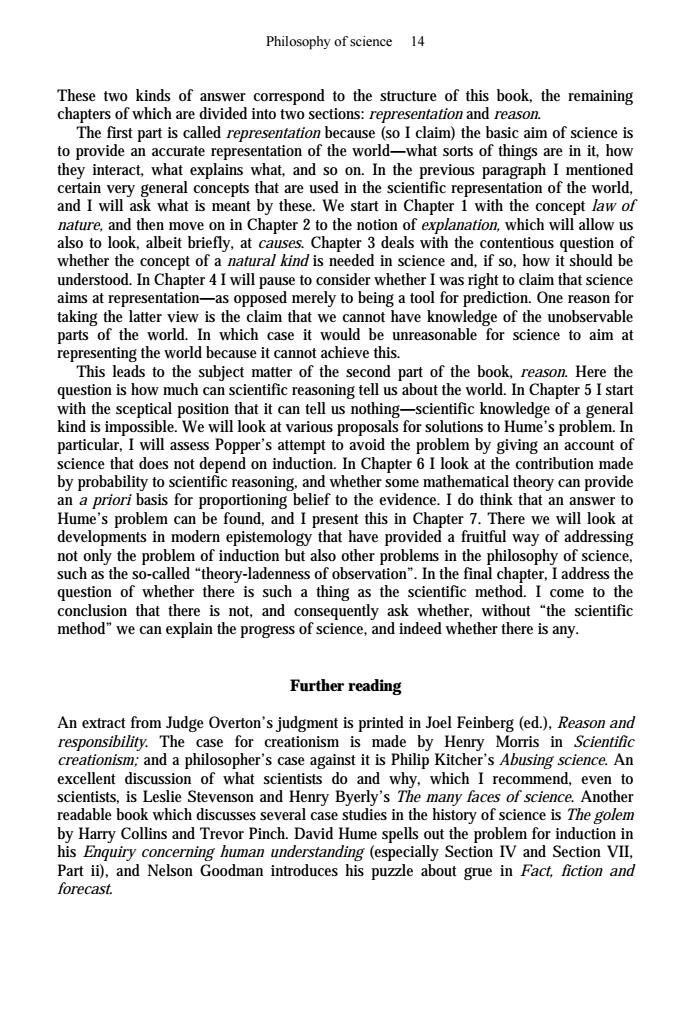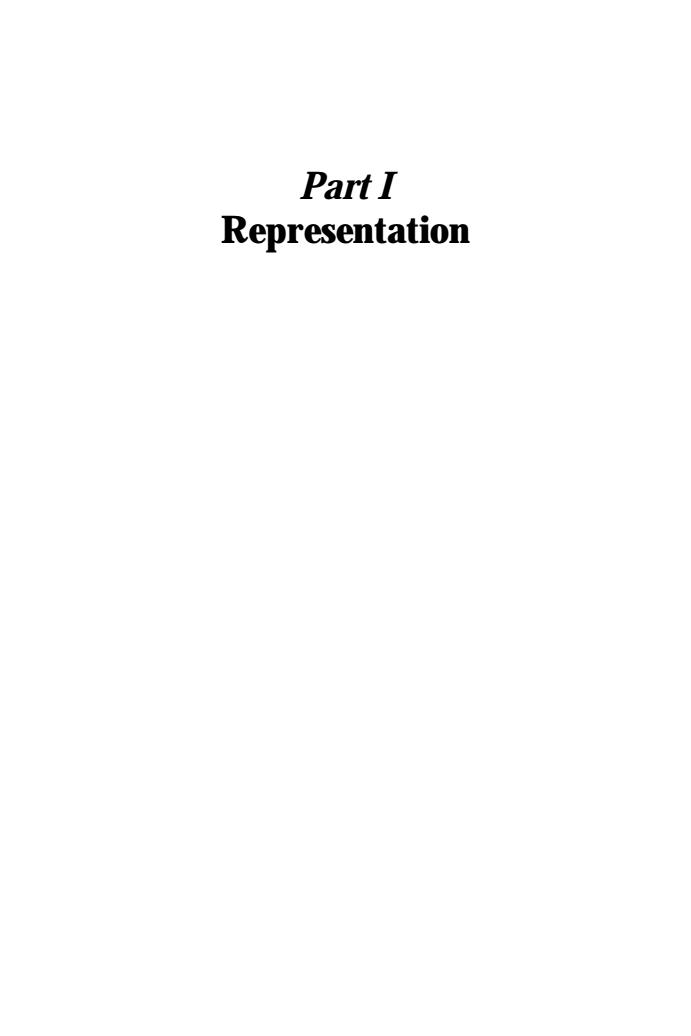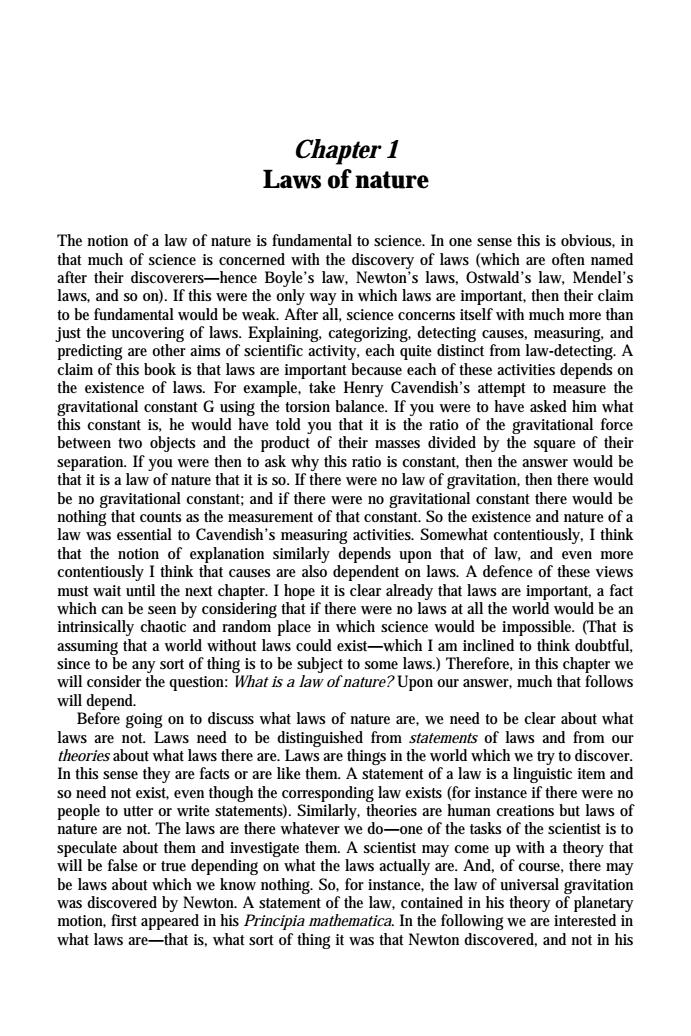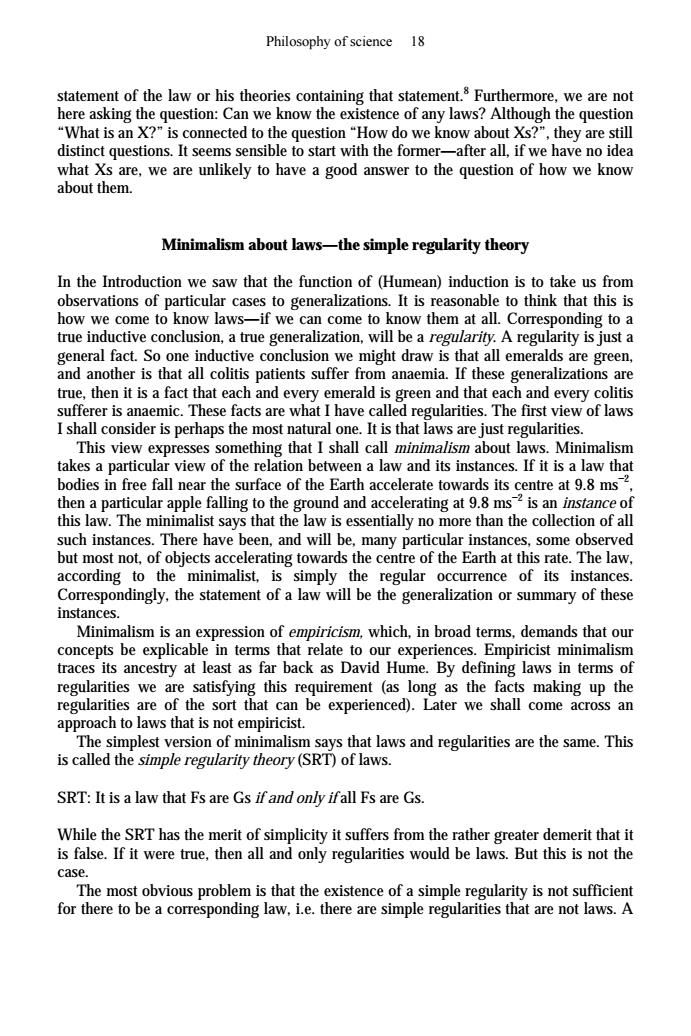
Philosophy of science 14 These two kinds of answer correspond to the structure of this book,the remaining chapters of which are divided into two sections:representation and reason. The first part is called representation because (so I claim)the basic aim of science is to provide an accurate representation of the world-what sorts of things are in it,how they interact,what explains what,and so on.In the previous paragraph I mentioned certain very general concepts that are used in the scientific representation of the world, and I will ask what is meant by these.We start in Chapter 1 with the concept law of nature,and then move on in Chapter 2 to the notion of explanation,which will allow us also to look,albeit briefly,at causes.Chapter 3 deals with the contentious question of whether the concept of a natural kind is needed in science and,if so,how it should be understood.In Chapter 4 I will pause to consider whether I was right to claim that science aims at representation-as opposed merely to being a tool for prediction.One reason for taking the latter view is the claim that we cannot have knowledge of the unobservable parts of the world.In which case it would be unreasonable for science to aim at representing the world because it cannot achieve this. This leads to the subject matter of the second part of the book,reason.Here the question is how much can scientific reasoning tell us about the world.In Chapter 5 I start with the sceptical position that it can tell us nothing-scientific knowledge of a general kind is impossible.We will look at various proposals for solutions to Hume's problem.In particular,I will assess Popper's attempt to avoid the problem by giving an account of science that does not depend on induction.In Chapter 6 I look at the contribution made by probability to scientific reasoning,and whether some mathematical theory can provide an a priori basis for proportioning belief to the evidence.I do think that an answer to Hume's problem can be found,and I present this in Chapter 7.There we will look at developments in modern epistemology that have provided a fruitful way of addressing not only the problem of induction but also other problems in the philosophy of science, such as the so-called "theory-ladenness of observation".In the final chapter,I address the question of whether there is such a thing as the scientific method.I come to the conclusion that there is not,and consequently ask whether,without "the scientific method"we can explain the progress of science,and indeed whether there is any. Further reading An extract from Judge Overton's judgment is printed in Joel Feinberg (ed.),Reason and responsibility.The case for creationism is made by Henry Morris in Scientific creationism:and a philosopher's case against it is Philip Kitcher's Abusing science.An excellent discussion of what scientists do and why,which I recommend,even to scientists,is Leslie Stevenson and Henry Byerly's The many faces of science.Another readable book which discusses several case studies in the history of science is The golem by Harry Collins and Trevor Pinch.David Hume spells out the problem for induction in his Enquiry concerning human understanding (especially Section IV and Section VII, Part ii),and Nelson Goodman introduces his puzzle about grue in Fact,fiction and forecast
These two kinds of answer correspond to the structure of this book, the remaining chapters of which are divided into two sections: representation and reason. The first part is called representation because (so I claim) the basic aim of science is to provide an accurate representation of the world—what sorts of things are in it, how they interact, what explains what, and so on. In the previous paragraph I mentioned certain very general concepts that are used in the scientific representation of the world, and I will ask what is meant by these. We start in Chapter 1 with the concept law of nature, and then move on in Chapter 2 to the notion of explanation, which will allow us also to look, albeit briefly, at causes. Chapter 3 deals with the contentious question of whether the concept of a natural kind is needed in science and, if so, how it should be understood. In Chapter 4 I will pause to consider whether I was right to claim that science aims at representation—as opposed merely to being a tool for prediction. One reason for taking the latter view is the claim that we cannot have knowledge of the unobservable parts of the world. In which case it would be unreasonable for science to aim at representing the world because it cannot achieve this. This leads to the subject matter of the second part of the book, reason. Here the question is how much can scientific reasoning tell us about the world. In Chapter 5 I start with the sceptical position that it can tell us nothing—scientific knowledge of a general kind is impossible. We will look at various proposals for solutions to Hume’s problem. In particular, I will assess Popper’s attempt to avoid the problem by giving an account of science that does not depend on induction. In Chapter 6 I look at the contribution made by probability to scientific reasoning, and whether some mathematical theory can provide an a priori basis for proportioning belief to the evidence. I do think that an answer to Hume’s problem can be found, and I present this in Chapter 7. There we will look at developments in modern epistemology that have provided a fruitful way of addressing not only the problem of induction but also other problems in the philosophy of science, such as the so-called “theory-ladenness of observation”. In the final chapter, I address the question of whether there is such a thing as the scientific method. I come to the conclusion that there is not, and consequently ask whether, without “the scientific method” we can explain the progress of science, and indeed whether there is any. Further reading An extract from Judge Overton’s judgment is printed in Joel Feinberg (ed.), Reason and responsibility. The case for creationism is made by Henry Morris in Scientific creationism; and a philosopher’s case against it is Philip Kitcher’s Abusing science. An excellent discussion of what scientists do and why, which I recommend, even to scientists, is Leslie Stevenson and Henry Byerly’s The many faces of science. Another readable book which discusses several case studies in the history of science is The golem by Harry Collins and Trevor Pinch. David Hume spells out the problem for induction in his Enquiry concerning human understanding (especially Section IV and Section VII, Part ii), and Nelson Goodman introduces his puzzle about grue in Fact, fiction and forecast. Philosophy of science 14

Part I Representation
Part I Representation


Chapter 1 Laws of nature The notion of a law of nature is fundamental to science.In one sense this is obvious,in that much of science is concerned with the discovery of laws (which are often named after their discoverers-hence Boyle's law,Newton's laws,Ostwald's law,Mendel's laws,and so on).If this were the only way in which laws are important,then their claim to be fundamental would be weak.After all,science concerns itself with much more than just the uncovering of laws.Explaining,categorizing,detecting causes,measuring.and predicting are other aims of scientific activity,each quite distinct from law-detecting.A claim of this book is that laws are important because each of these activities depends on the existence of laws.For example,take Henry Cavendish's attempt to measure the gravitational constant G using the torsion balance.If you were to have asked him what this constant is,he would have told you that it is the ratio of the gravitational force between two objects and the product of their masses divided by the square of their separation.If you were then to ask why this ratio is constant,then the answer would be that it is a law of nature that it is so.If there were no law of gravitation,then there would be no gravitational constant;and if there were no gravitational constant there would be nothing that counts as the measurement of that constant.So the existence and nature of a law was essential to Cavendish's measuring activities.Somewhat contentiously,I think that the notion of explanation similarly depends upon that of law,and even more contentiously I think that causes are also dependent on laws.A defence of these views must wait until the next chapter.I hope it is clear already that laws are important,a fact which can be seen by considering that if there were no laws at all the world would be an intrinsically chaotic and random place in which science would be impossible.(That is assuming that a world without laws could exist-which I am inclined to think doubtful, since to be any sort of thing is to be subject to some laws.)Therefore,in this chapter we will consider the question:What is a law of nature?Upon our answer,much that follows will depend. Before going on to discuss what laws of nature are,we need to be clear about what laws are not.Laws need to be distinguished from statements of laws and from our theories about what laws there are.Laws are things in the world which we try to discover. In this sense they are facts or are like them.A statement of a law is a linguistic item and so need not exist,even though the corresponding law exists (for instance if there were no people to utter or write statements).Similarly,theories are human creations but laws of nature are not.The laws are there whatever we do-one of the tasks of the scientist is to speculate about them and investigate them.A scientist may come up with a theory that will be false or true depending on what the laws actually are.And,of course,there may be laws about which we know nothing.So,for instance,the law of universal gravitation was discovered by Newton.A statement of the law,contained in his theory of planetary motion,first appeared in his Principia mathematica.In the following we are interested in what laws are-that is,what sort of thing it was that Newton discovered,and not in his
Chapter 1 Laws of nature The notion of a law of nature is fundamental to science. In one sense this is obvious, in that much of science is concerned with the discovery of laws (which are often named after their discoverers—hence Boyle’s law, Newton’s laws, Ostwald’s law, Mendel’s laws, and so on). If this were the only way in which laws are important, then their claim to be fundamental would be weak. After all, science concerns itself with much more than just the uncovering of laws. Explaining, categorizing, detecting causes, measuring, and predicting are other aims of scientific activity, each quite distinct from law-detecting. A claim of this book is that laws are important because each of these activities depends on the existence of laws. For example, take Henry Cavendish’s attempt to measure the gravitational constant G using the torsion balance. If you were to have asked him what this constant is, he would have told you that it is the ratio of the gravitational force between two objects and the product of their masses divided by the square of their separation. If you were then to ask why this ratio is constant, then the answer would be that it is a law of nature that it is so. If there were no law of gravitation, then there would be no gravitational constant; and if there were no gravitational constant there would be nothing that counts as the measurement of that constant. So the existence and nature of a law was essential to Cavendish’s measuring activities. Somewhat contentiously, I think that the notion of explanation similarly depends upon that of law, and even more contentiously I think that causes are also dependent on laws. A defence of these views must wait until the next chapter. I hope it is clear already that laws are important, a fact which can be seen by considering that if there were no laws at all the world would be an intrinsically chaotic and random place in which science would be impossible. (That is assuming that a world without laws could exist—which I am inclined to think doubtful, since to be any sort of thing is to be subject to some laws.) Therefore, in this chapter we will consider the question: What is a law of nature? Upon our answer, much that follows will depend. Before going on to discuss what laws of nature are, we need to be clear about what laws are not. Laws need to be distinguished from statements of laws and from our theories about what laws there are. Laws are things in the world which we try to discover. In this sense they are facts or are like them. A statement of a law is a linguistic item and so need not exist, even though the corresponding law exists (for instance if there were no people to utter or write statements). Similarly, theories are human creations but laws of nature are not. The laws are there whatever we do—one of the tasks of the scientist is to speculate about them and investigate them. A scientist may come up with a theory that will be false or true depending on what the laws actually are. And, of course, there may be laws about which we know nothing. So, for instance, the law of universal gravitation was discovered by Newton. A statement of the law, contained in his theory of planetary motion, first appeared in his Principia mathematica. In the following we are interested in what laws are—that is, what sort of thing it was that Newton discovered, and not in his

Philosophy of science 18 statement of the law or his theories containing that statement.3 Furthermore,we are not here asking the question:Can we know the existence of any laws?Although the question "What is an X?"is connected to the question "How do we know about Xs?",they are still distinct questions.It seems sensible to start with the former-after all,if we have no idea what Xs are,we are unlikely to have a good answer to the question of how we know about them. Minimalism about laws-the simple regularity theory In the Introduction we saw that the function of (Humean)induction is to take us from observations of particular cases to generalizations.It is reasonable to think that this is how we come to know laws-if we can come to know them at all.Corresponding to a true inductive conclusion,a true generalization,will be a regularity.A regularity is just a general fact.So one inductive conclusion we might draw is that all emeralds are green, and another is that all colitis patients suffer from anaemia.If these generalizations are true,then it is a fact that each and every emerald is green and that each and every colitis sufferer is anaemic.These facts are what I have called regularities.The first view of laws I shall consider is perhaps the most natural one.It is that laws are just regularities. This view expresses something that I shall call minimalism about laws.Minimalism takes a particular view of the relation between a law and its instances.If it is a law that bodies in free fall near the surface of the Earth accelerate towards its centre at 9.8 ms, then a particular apple falling to the ground and accelerating at 9.8 ms is an instance of this law.The minimalist says that the law is essentially no more than the collection of all such instances.There have been,and will be,many particular instances,some observed but most not,of objects accelerating towards the centre of the Earth at this rate.The law. according to the minimalist,is simply the regular occurrence of its instances. Correspondingly,the statement of a law will be the generalization or summary of these instances. Minimalism is an expression of empiricism,which,in broad terms,demands that our concepts be explicable in terms that relate to our experiences.Empiricist minimalism traces its ancestry at least as far back as David Hume.By defining laws in terms of regularities we are satisfying this requirement (as long as the facts making up the regularities are of the sort that can be experienced).Later we shall come across an approach to laws that is not empiricist. The simplest version of minimalism says that laws and regularities are the same.This is called the simple regularity theory(SRT)of laws. SRT:It is a law that Fs are Gs if and only ifall Fs are Gs. While the SRT has the merit of simplicity it suffers from the rather greater demerit that it is false.If it were true,then all and only regularities would be laws.But this is not the case. The most obvious problem is that the existence of a simple regularity is not sufficient for there to be a corresponding law,i.e.there are simple regularities that are not laws.A
statement of the law or his theories containing that statement.8 Furthermore, we are not here asking the question: Can we know the existence of any laws? Although the question “What is an X?” is connected to the question “How do we know about Xs?”, they are still distinct questions. It seems sensible to start with the former—after all, if we have no idea what Xs are, we are unlikely to have a good answer to the question of how we know about them. Minimalism about laws—the simple regularity theory In the Introduction we saw that the function of (Humean) induction is to take us from observations of particular cases to generalizations. It is reasonable to think that this is how we come to know laws—if we can come to know them at all. Corresponding to a true inductive conclusion, a true generalization, will be a regularity. A regularity is just a general fact. So one inductive conclusion we might draw is that all emeralds are green, and another is that all colitis patients suffer from anaemia. If these generalizations are true, then it is a fact that each and every emerald is green and that each and every colitis sufferer is anaemic. These facts are what I have called regularities. The first view of laws I shall consider is perhaps the most natural one. It is that laws are just regularities. This view expresses something that I shall call minimalism about laws. Minimalism takes a particular view of the relation between a law and its instances. If it is a law that bodies in free fall near the surface of the Earth accelerate towards its centre at 9.8 ms−2 , then a particular apple falling to the ground and accelerating at 9.8 ms−2 is an instance of this law. The minimalist says that the law is essentially no more than the collection of all such instances. There have been, and will be, many particular instances, some observed but most not, of objects accelerating towards the centre of the Earth at this rate. The law, according to the minimalist, is simply the regular occurrence of its instances. Correspondingly, the statement of a law will be the generalization or summary of these instances. Minimalism is an expression of empiricism, which, in broad terms, demands that our concepts be explicable in terms that relate to our experiences. Empiricist minimalism traces its ancestry at least as far back as David Hume. By defining laws in terms of regularities we are satisfying this requirement (as long as the facts making up the regularities are of the sort that can be experienced). Later we shall come across an approach to laws that is not empiricist. The simplest version of minimalism says that laws and regularities are the same. This is called the simple regularity theory (SRT) of laws. SRT: It is a law that Fs are Gs if and only if all Fs are Gs. While the SRT has the merit of simplicity it suffers from the rather greater demerit that it is false. If it were true, then all and only regularities would be laws. But this is not the case. The most obvious problem is that the existence of a simple regularity is not sufficient for there to be a corresponding law, i.e. there are simple regularities that are not laws. A Philosophy of science 18